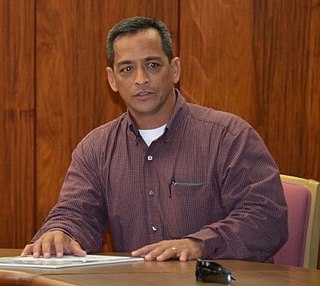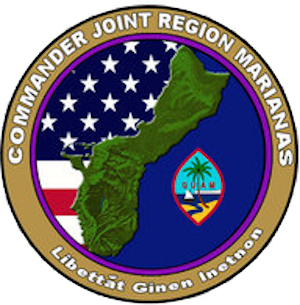Related Research Articles

Guam is an organized, unincorporated territory of the United States in the Micronesia subregion of the western Pacific Ocean. Guam's capital is Hagåtña, and the most populous village is Dededo. It is the westernmost point and territory of the United States, reckoned from the geographic center of the U.S. In Oceania, Guam is the largest and southernmost of the Mariana Islands and the largest island in Micronesia.

Hagåtña is the capital village of the United States territory of Guam. From the 18th through mid-20th century, it was Guam's population center, but today it is the second smallest of the island's 19 villages in both area and population. However, it remains one of the island's major commercial districts in addition to being the seat of government.

Territories of the United States are sub-national administrative divisions overseen by the federal government of the United States. The various American territories differ from the U.S. states and Indian reservations as they are not sovereign entities. In contrast, each state has a sovereignty separate from that of the federal government and each federally recognized Native American tribe possesses limited tribal sovereignty as a "dependent sovereign nation." Territories are classified by incorporation and whether they have an "organized" government through an organic act passed by the Congress. American territories are under American sovereignty and, consequently, may be treated as part of the United States proper in some ways and not others. Unincorporated territories in particular are not considered to be integral parts of the United States, and the Constitution of the United States applies only partially in those territories.

Tamuning, also known as Tamuning-Tumon-Harmon is a village located on the western shore of the United States territory of Guam. The village of Tamuning is the economic center of Guam, containing tourist center Tumon, Harmon Industrial Park, and other commercial districts. Its central location along Marine Corps Drive, the island's main thoroughfare, has aided in its development.

The Republican Party of Guam, commonly referred to as Guam GOP, is a political party in Guam affiliated with the United States Republican Party.

Piti is a village located on the central west coast of the United States territory of Guam. It contains northern and eastern coastlines of Apra Harbor, including Cabras Island, which has the commercial Port of Guam and the island's largest power plants. Piti was a pre-Spanish CHamoru village and, after Spanish colonization, became the primary port town on Guam. The town was largely destroyed during the 1944 liberation of Guam and the population relocated during the wartime construction of Apra Harbor.
The Government of Guam (GovGuam) is a presidential representative democratic system, whereby the president is the head of state and the governor is head of government, and of a multi-party system. Guam is an organized, unincorporated territory of the United States with policy relations between Guam and the US under the jurisdiction of the Office of Insular Affairs.
The economy of Guam depends mainly on US military spending and on tourist revenue. Over the past 20 years, the tourist industry grew rapidly, creating a construction boom for new hotels, golf courses and other tourist amenities. More than 1.1 million tourists visit Guam each year including about 1,000,000 from Japan and 150,000 from Korea. Setbacks in the 1990s include numerous super-typhoons, a M7.8 earthquake, and a Korean airline crash.

Guam Memorial Hospital is located in Tamuning, Guam and is the only public hospital serving the island of Guam. The hospital has 161 licensed acute care beds, plus 40 beds at its off-site, long-term care Skilled Nursing Facility (SNF).
The Guam Department of Corrections is an agency of the government of the United States territory of Guam that operates the island's correctional facilities.
The Guam Department of Youth Affairs is the youth corrections agency of the United States territory of Guam. The department has its headquarters in the village of Mangilao. The Guam Youth Correctional Facility, operated by the department, is in Mangilao. The agency also operates the Cottage Homes, located in the village Talofofo. The Liheng Famaguon School provides educational services to inmates of the department.

Frank Blas Aguon Jr. is a Guamanian politician and army lieutenant. A Democrat, he served in the Legislature of Guam from 1997 to 2007, 2009 to 2011 and from 2013 to 2019. He is a former Vice-Speaker from 2003 to 2005.

Joint Region Marianas' mission is to provide installation management support to all Department of Defense components and tenants through assigned regional installations on Guam and the Northern Mariana Islands in support of training in the Marianas; to act as the interface between the Department of Defense and the civilian community; to ensure compliance with all environmental laws and regulations, safety procedures, and equal opportunity policy; and perform other functions and tasks as may be assigned.

Dededo is the most populated village in the United States territory of Guam. According to the U.S. Census Bureau, Dededo's population was just under 45,000 in 2020. The village is located on the coral plateau of Northern Guam. The greater Dededo-Machanao-Apotgan Urban Cluster had a population of 139,825 as of the 2010 census, making up 87.7% of Guam's population and 29.8% of its area.

Yigo, Guam is the northernmost village of the United States territory of Guam, and is the location of Andersen Air Force Base. The municipality of Yigo is the largest village on the island in terms of area. It contains a number of populated places, including Asatdas and Agafo Gumas.

Barrigada is a village in the United States territory of Guam. A largely residential municipality, its main village is located south of the Antonio B. Won Pat International Airport near the intersections of Routes 8, 10, and 16. The community east of the airport known as Barrigada Heights is considered an affluent neighborhood on the island, where homes have excellent views overlooking much of Guam including the island's airport and hotels along Tumon Bay. Another significant location is Mount Barrigada, nearly 200 meters above sea level. Its location in the center of the island means it houses most of the island's radio masts and towers; the position and height make it easier for radio signals to reach the entire island.

Mangilao is a village on the eastern shore of the United States territory of Guam. The village's population has decreased slightly since the island's 2010 census.
Henry Bertrand Price was a United States Navy Captain who served as the 30th Naval Governor of Guam. As a naval officer, he served on many assignments, including with the Bureau of Ordnance. In 1913, he became executive officer of USS Delaware, and two years later commanding officer of USS Melville. Becoming governor in 1923, Price focused on agricultural development, particularly in the region of Mangilao, Guam. He also ordered increased road building and the establishment of the Guam Department of Agriculture.

Edmund Spence Root was a United States Navy Captain who served as the 34th Naval Governor of Guam. He graduated from the United States Naval Academy in 1905, serving on many ships as an ensign. He served as the inaugural commanding officer of two ships: USS Rizal and USS Astoria. He served during World War I as commander of the U-boat hunting USS Rowan, for which he received a letter of commendation. As governor, he generated controversy by expelling 112 Japanese laborers from Guam. The Guam Museum also opened during his term of office.
Coffee production in Guam is limited to local consumption. Like cacao, coffee has been introduced to and thrives in Guam. In the early 20th century, coffee was described as one Guam's most common plants, growing about most of the dwelling houses, and nearly every family has its cultivated patch. The climate and soil of the island is well adapted to it, producing the crop from sea level to the hill tops.
References
- ↑ "Contact Us Archived 2010-05-27 at the Wayback Machine ." Guam Department of Agriculture. Retrieved on October 21, 2010.